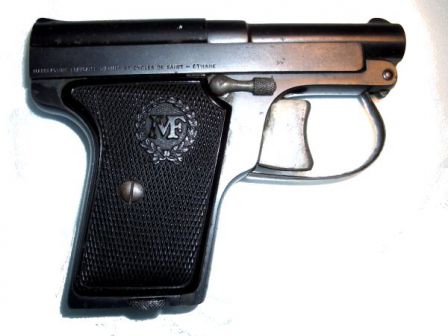Manufrance Le Français Pocket pistol, original model in 6.35mm caliber
Manufrance Le Français Policeman pistol, caliber 6.35mm
Manufrance Le Français Armee pistol, caliber 9mm
Manufrance Le Français Armee pistol, with barrel tipped up for loading. Barrel latch lever is visible above the trigger
Manufrance Le Français pistol in 7.65mm Browning (.32ACP) caliber,
model of 1950. Note that it has slide serrations and spent cartridge
extractor, unlike all previous models
Diagram from original French patent, issued to Manufrance, showing
the typical recoil spring arrangement of all Le Français pistols. The
lever which connects the slide with return spring is marked with grey
color. Two such levers are concealed under both side grip panels.
| Le Français Policeman, 1922 | Le Français Armee, 1928 | Le Français 7,65mm, 1950 | |
| Type | Double Action Only semiautomatic | ||
| Caliber(s) | 6.35x16SR / .25 ACP | 9x20SR Browning Long | 7,65x17SR / .32 ACP |
| Weight unloaded | 350 g | 960 g | 630 g |
| Length | 157 mm | 202 mm | 152 mm |
| Barrel length | 87 mm | 127 mm | 83 mm |
| Magazine capacity | 7 rounds | 8 rounds | 8 rounds |
Le Français (Le Francais) semi-automatic pistols were originally
developed in 1913 by French small arms designer Etienne Mimard, who at
the time worked for the French company Manufacture Française d’Armes et
de Cycles de Saint-Étienne, which was later renamed to Manufrance. This
was simple and unorthodox weapon, which was put into production in 1914
as a pocket-type personal defense sidearm, chambered for then-popular
6.35mm Browning (.25ACP) cartridge, and designated as "Le Francais" (the
French). In 1922 the basic "Pocket" model was fitted with enlarged
barrel and a spare round loop at the base of the magazine, and became
the Le Français "Policeman" pistol. this weapon was manufactured by
Manufrance until 1968, and sold to various police units in France, as
well as to general public. In 1928 Manufrance introduced the biggest of
the Le Français series pistols, known as the Armee (Army) model. It was
submitted for French army trials but eventually lost. Nevertheless, the
Le Français Armee pistol, chambered for 9mm Browning Long ammunition,
was put into production, which lasted until 1939, with slightly less
than 5000 Army model pistols made. Since 1950 Manufrance also
manufactured a 7,65mm Browning caliber pistol under the same label,
which was sold mostly for civilian markets. This model was the only one
of the whole "Le Français" series to have slide serrations, and it was
manufactured by Manufrance between 1950 and 1965.
All Manufrance Le Français pistols used simple blowback action. The
return spring was located vertically in the grip, ahead of the magazine
well. It was connected to the slide with dual rocking levers, located
below each grip panel. When slide recoiled, these levers pivoted back
and compressed the return spring. The barrel was connected to the frame
by the pivot below the muzzle and by the simple catch below the chamber
(breech). There was no extractor, and spent cartridges were thrown out
of the barrel by gas pressure. Dud or unfired cartridges were extracted
manually, often with the help of the cleaning rod or other similar
object. Since there was no normal way to manually cycle the slide, user
had to release the barrel lock (push the lever, located above the
trigger on the right side of the frame), and then tip the rear part of
the barrel up, exposing its breech. Once barrel was tipped up, user was
able to load cartridge directly into the chamber or manually extract
unfired cartridge. The only standard way to fully load the gun was to
manually load the round into the chamber and then insert the full
magazine. To facilitate faster reloading, some models were fitted with
spare cartridge loop at the magazine base. This loop held additional
cartridge which user had to hand load into the chamber before inserting
the fresh magazine. Magazines were of single stack design, magazine
release was located at the base of the grip. The trigger was of
double-action only type, striker fired. No manual safety was provided.
The 7,65mm Le Français pistols of post-WW2 manufacture were modified
with addition of conventional external extractor and slide serrations,
which allowed for more conventional loading and unloading procedure. The
tipping barrel, however, was retained.






Tidak ada komentar:
Posting Komentar